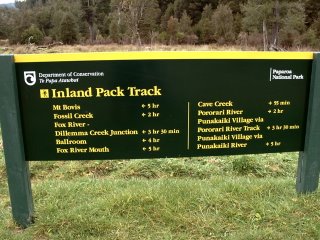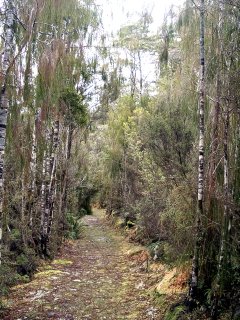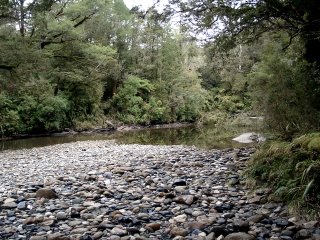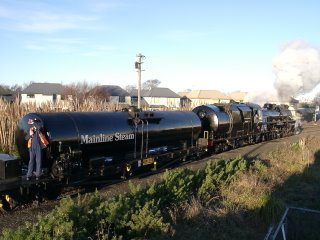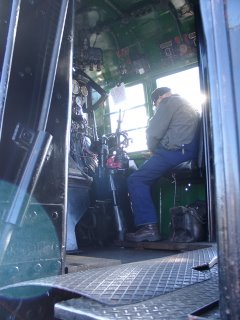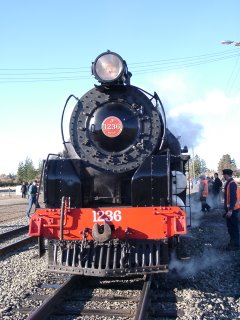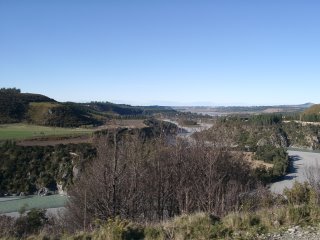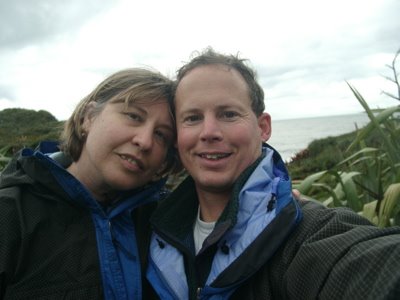Tranquil Lake Tekapo
On the weekend of 4-6 August, Gaby and I made our first trip south of Christchurch to Lake Tekapo. We met up with our friends Dave and Elizabeth for a weekend of fun exploring the area. We left Christchurch early Friday afternoon so we could see the countryside in daylight. From Christchurch we traveled south on State Highway 1. When we reached Rangitata we turned off onto State Highway 79 through Geraldine to Fairlie.
Just after turning onto State Highway 79 we passed through the small town of Geraldine, where we both just happened to spot a cheese shop, so we had to stop and see what they had :-) The cheese shop, located in the Berry Barn Complex, stalks a fresh selection of Talbot Forest Cheeses, a local artisanal cheesemaker. After perusing their unexpectedly fine selection of artisanal cheeses, we bought a wonderful blue cheese and a hard sheep's milk cheese with chives. I also bought a nice cast iron fondue set - a definite necessity.

From Geraldine we made our way to Fairlie and the junction with State Highway 8, where we headed west over Burke's Pass and entered Mackenzie Country, named after James McKenzie (this is supposedly his actual name), an early explorer and supposed sheep wrangler. The Mackenzie Country refers to the upland area lying in the foothills of the Southern Alps and contains several mountain lakes, including Lake Tekapo. State Highway 8 winds through the Albury Range, then drops to a large plain of rolling hills with an astonishing view of the surrounding snow capped peaks.
The lakes in this area (and others around New Zealand) contain what is referred to as glacial flour, a fine particulate matter eroded from the surrounding mountains by, you guessed it - glaciers. This glacial flour defracts sunlight and causes the brilliant azure blue and turquoise colors of the lakes, adding to the already picturesque environment.
We finally arrived at our weekend bach (that's Kiwi for a weekend cottage) around 5:00 pm. Dave and Elizabeth arrived shortly thereafter, and we then decided to walk to the store and buy something to cook for dinner.

We settled on a community cooked affair of a great Indian vegetable curry with fresh broccoli, kumara (Kiwi for yam), cauliflower, etc, along with a wonderful rice. To accent this savory meal we bought a good Tripel, a locally produced specialty beer from Monteith's - it's quite nice.
That evening we settled in for a relaxing evening by the fire and decided what we wanted to do for Saturday. We were told of a good ski resort called Ohau, within about an hour of Tekapo and we decided to check it out. Gaby opted out of skiing because her shoulder was still bothering her, so she decided to take a short hike around Tekapo and visit some of the famous sights along the shoreline.
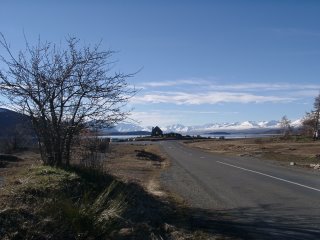
Saturday morning Gaby took advantage of the opportunity of a warm quiet morning to sleep in to her heart's content before setting out to see the sights. A church, the Church of The Good Shepherd, was built on the shoreline in 1935. I suppose part of what makes this building so popular is its setting amongst such beautiful mountains. Lake Tekapo lies along a major route to Mt. Cook and during the height of the tourist season bus loads of folks flock to the church along the shores of the lake. It may also help that there are restroom facilities nearby :-)

Not far from the Church of the Good Shepherd is a statue of a collie dog. The bronze sculpture stands as a tribute to all the working collie dogs of the area.

The Tribute:
"This monument was erected by the Runkolders of the Mackenzie County and those who also appreciate the value of the collie dog, without the help of which the grazing of this mountain country would be impossible."
On Saturday I joined Dave and Elizabeth on a trip to the ski resort Ohau. I had only been on skis once before and was keen to get some instruction on the basics. We headed off towards the skifield, winding through the hills and valleys, always heading towards the precipitous snow capped peaks. It is very evident this area was carved by glaciers, as most of the mountains rise from the valley floors at a heart stopping incline. This was where things got fun. Being from Southern California, I am used to wide, paved roads leading to expansive parking lots. The roads to ski fields are a wee bit different here in New Zealand. Keep in mind that it's currently winter here, with ice and snow on many of the roads, and we were driving in a two wheel drive car.
The ski fields are at the top of the tall rugged peaks and the only access is via narrow single lane dirt roads carved into the mountainside - with no guardrails! Just the drive to the parking area was exhilarating. I suppose that during storms no one can access these resorts. I was glad for our fine weather.
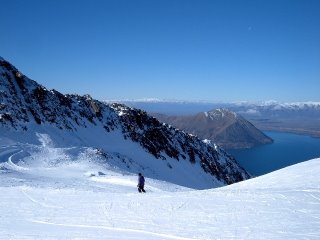
Dave and I rented skis and headed off for our basic ski training session while Elizabeth headed for the slopes for a bit of intermediate instruction. Ohau has a neat conveyer belt system called "The Magic Carpet" which you can ski onto for a ride to the top of the bunny slope - Cool! Our instructor was friendly and knowledgeable and taught us the basics of maneuvering around on skis with the snow plow technique. I had a blast on the bunny slope practicing turns and stopping. I am definitely excited about skiing - what a blast!
We left Ohau around 3:00 pm and headed back to Lake Tekapo to meet up again with Gaby. After cleaning up we all ventured over to a local tavern for a couple of pizzas.
On Sunday we all slept in and enjoyed a lazy breakfast before deciding on what to do next. We all wanted to get out and hike a bit so we decided to walk from Lake Tekapo to the top of Mt. John, just above Lake Tekapo, where the University of Canterbury has built an observatory. Lake Tekapo boasts that it has the darkest sky in all of New Zealand, and is also one of the darkest skies in the world. After seeing so many stars come out at night I don't doubt it. An outfit called Earth and Sky organizes guided tours of the facility.

The area around Lake Tekapo is full of tracks (Kiwi for hiking trails). This particular track zig zagged up the steep face of Mt. John, but was definitely worth the effort (you can drive to the top of Mt. John if you want to.) The summit of Mt. John gave us a great view of Lake Tekapo and its namesake town. You also get a wonderful panoramic view of the surrounding snow capped peaks.

After a brief but necessary stop to eat some potato chips we headed back down the trail towards Lake Tekapo. The air was crisp but the scenery was great.

We enjoyed our first trip south of Christchurch and look forward to exploring a bit farther south in the near future.


